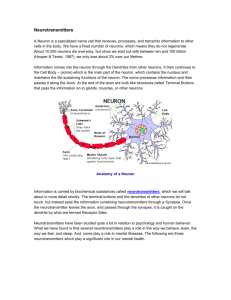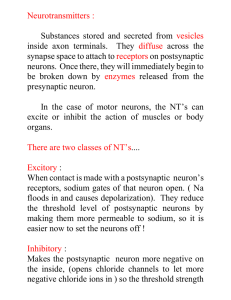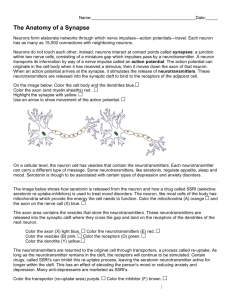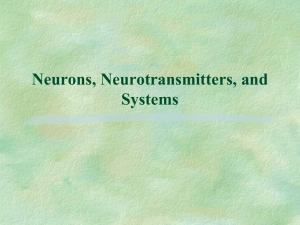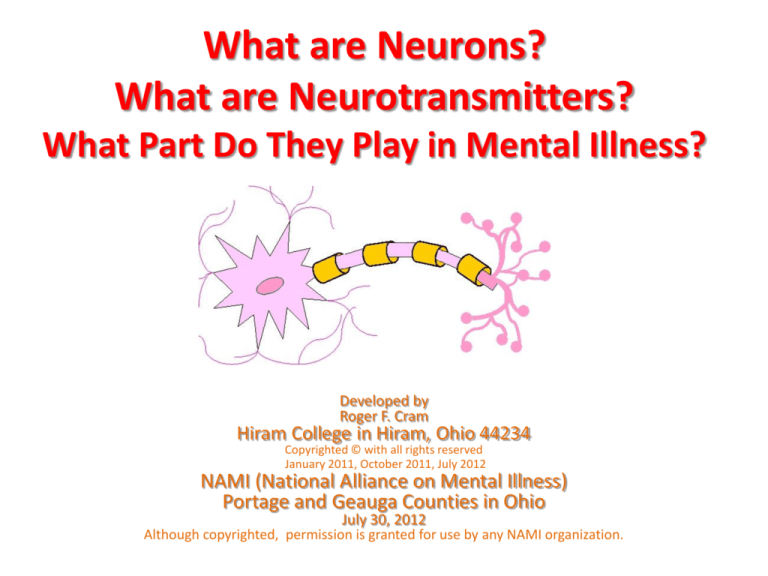
What are Neurons?
What are Neurotransmitters?
What Part Do They Play in Mental Illness?
Developed by
Roger F. Cram
Hiram College in Hiram, Ohio 44234
Copyrighted © with all rights reserved
January 2011, October 2011, July 2012
NAMI (National Alliance on Mental Illness)
Portage and Geauga Counties in Ohio
July 30, 2012
Although copyrighted, permission is granted for use by any NAMI organization.
Electrical signals travel from the brain along
the neurons (wires) to a particular device like
a muscle cell, a heart cell, lungs, eyes, ears,
liver, a feeling, a thought, an emotion, a
dream, etc.
neurons from www.images.wellcome.co.uk
Neurons in the brain - illustration. Credit: Benedict Campbell.
What do neurons look like?
There are 10 billion nerve cells in the brain.
Transductions – neurons – Feb. 4th, 2010 by Wolf
IMAGES FROM RESEARCH - NEURONS AND NEURONAL PROTEINS by Robert S. McNeil
Dendrites:
Electriccharge
receivers
Soma
(Cell Body)
Direction of electrical charge
to the next neuron
Axon
Myelin
Cell nucleus
Axons:
Electric
charge
transmitters
Source: Modeling Future Heroes, A Practical Application of Heroic Values, By Roger F. Cram
How Does a Neuron Carry An
Electrical Charge?
Neurons attach to each other through the
synapse gap (doorbell button or electric
switch) carrying an electrical charge from one
neuron to the other. These neurons form the
“wires” or nerves carrying information
throughout our body.
Often many neurons
are linked together
where the dendrite
connects to the axon
carrying electrical
signals along their
path.
Axon
Dendrite
Electrical
Connection
Direction of current flow
Source: Modeling Future Heroes, A Practical Application of Heroic Values, By Roger F. Cram
Dendrites Connected to Axons Act Like Electric Switches
Allowing an Electrical Charge to Move Along a Wire
SWITCH
Axon
Dendrite
Source: Modeling Future Heroes, A Practical Application of Heroic Values, By Roger F. Cram
Involuntary Neurons
Neurons are used to carry electrical signals for
involuntary processes: digest your food, keep
your heart beating, repair cells, clean your
blood, create thoughts and emotions (fear,
lust, jealousy, self-esteem), carry light images
from your eyes to your brain, create hearingtouch-taste-smell, fight disease, grow a baby,
create the sensation of hunger, etc….
Voluntary Neurons
Neurons are also used to carry electrical
signals for voluntary movements like moving
muscles (running, walking, writing, working,
typing, taking a bath, getting dressed, driving
a car) or for thinking (solving a problem,
creating art, reading a book, meditating,
imagining things).
Neuron Signals
• Your brain triggers six trillion electrical signals
through your neurons every second to operate
your body and allow you freedom of thought,
movement and life.
• How much is six trillion? Well, six trillion
pennies stacked end-on-end, would go from
the earth to the moon, 243,000 miles, twentyfour times!
• Mental illness is a disease of
these electrical circuits in the
brain.
The electrical signal is passed from one
neuron to the next to the next until it is either
blocked or it reaches its targeted device
(muscle, thought, heart beat, eye, tongue,
hand, etc.). That’s how memory works, how
the entire body works, how we think, how our
emotions make us aware of pleasure, panic,
and sorrow; that’s how we run, speak, fight
disease, heal a scratch, see, hear, taste, touch,
yell at our kids – all through electrical
connections going through nerves carried
from one neuron to the next.
Synapse Connection (switch)
Axon Connected to a Dendrite)
Axon
Dendrite
Source: Modeling Future Heroes, A Practical Application of Heroic Values, By Roger F. Cram
What does the connection
of two neurons look like?
Axon end
Synaptic Cleft
(the gap)
Electrical Connection
The Brain Bank Your plastic brain
Posted on June 20, 2011 by Brain Bank Manc
Dendrite end
AXON TERMINAL END
End of first
neuron
Start of next
neuron
Dendrite End
Source: Modeling Future Heroes, A Practical Application of Heroic Values, By Roger F. Cram
The Synapse Gap
Neurons, although they carry the electrical
charge from one neuron to the next, are not
actually touching each other, but separated
by a very small gap called the “synapse cleft
or gap” serving as an open switch or
doorbell button. Something must happen to
push the doorbell button, to throw the
switch, to carry the electrical charge across
this gap to the next neuron.
End of first neuron
Incoming electrical
charge
AXON TERMINAL END
Start of next
neuron
There is a gap or
empty space
between the two
connecting neurons.
Gap or
Synaptic Cleft
Dendrite
Source: Modeling Future Heroes, A Practical Application of Heroic Values, By Roger F. Cram
When an electrical charge reaches
the end of the first neuron at the
axon, it causes vesicles, being tiny
bags containing chemical
neurotransmitters, to drop down and
release their contents into the
synapse cleft or gap. The yellow
Receptor
round molecules represent one of
over 100 different chemicals your
brain uses as neurotransmitters to
carry the electrical charge across the
gap to the dendrite receptors, being
the next neuron. This transfer of
electrical-to-chemical-to-electrical
information is how the brain controls
all functions necessary for life.
AXON
Vesicles
Neurotransmitters
Dendrite
Let’s take another look at this
illustration. Notice the vesicles?
Axon end
Synaptic Cleft
(the gap)
Electrical Connection
The Brain Bank Your plastic brain
Posted on June 20, 2011 by Brain Bank Manc
Dendrite end
Incoming electrical
charge
AXON TERMINAL END
Vesicle
Neurotransmitter
(Serotonin)
Start of next
neuron
Receptor
Dendrite
Continuation of
charge to
next neuron.
Source: Modeling Future Heroes, A Practical Application of Heroic Values, By Roger F. Cram
Source: NAMI–Family to Family Course, Class 6, Handout 2–Basic Neuro-transmission at the Synapse–page 6.23 Paragraph 3
Neurotransmitters
If the neurotransmitter (chemical making the
electrical connection between two neurons) is in
the part of the brain controlling the beating heart,
the electrical impulses will go along the chain of
neurons to the heart muscle causing it to pump.
If the neurons are in the part of the brain
controlling voluntary muscle control, and you are
trying to wave good-bye, the electrical impulses
will go along a chain of neurons to the muscle
cells in the arm allowing you to wave good-bye.
Neurotransmitters
If the neurons are in the part of the brain
controlling emotions, and you are in a crisis
situation, instinct will trigger the electrical
neurotransmitter impulses resulting in the
fight-or-flight response and the necessary
emotions and muscle action (fighting,
yelling, threatening, blocking an attack,
fleeing, running, jumping out of the way,
etc.).
Neurotransmitters
If the neurons are in the part of the brain
controlling emotions and you are Bipolar,
extra neurotransmitters may carry excessive
electrical “good feeling” impulses (manic) or
insufficient neurotransmitters may carry a
deficient amount of “good feeling” impulses
(depression) without your permission. The
neurons and neurotransmitters simply take
over. This is what many experts think happens
with bipolar, but they’re not absolutely sure.
In the following illustration, the
neurotransmitter is serotonin
(yellow circle ) and it carries the
electrical charge from the axon into
the gap. When enough serotonin
binds into the receptors of the next
neuron, the electric charge will be
forwarded. This communication
between neurons is brief, lasting
about 1 millisecond.
Incoming electrical
charge
AXON TERMINAL END
Vesicle
Neurotransmitter
(Serotonin)
Start of next
neuron
Receptor
Dendrite
Continuation of
charge to
next neuron
Source: Modeling Future Heroes, A Practical Application of Heroic Values, By Roger F. Cram
The serotonin molecules are shown as round and the
receptors (docking sites) that receive them are the
correctly sized semi-circular dish so the round serotonin
molecule fits perfectly into the receptor, thus transmitting
the electric charge.
Source: NAMI – Family to Family Course, Class 6, Handout 2 – Basic Neuro-transmission at the Synapse – page 6.23
Incoming
electrical
charge
AXON TERMINAL END
Vesicle
Gap or
Synaptic
Cleft
Start of next
neuron
Receptor
Dendrite
Continuation
of charge to
next neuron.
Source: Modeling Future Heroes, A Practical Application of Heroic Values, By Roger F. Cram
If a chemical other than the round serotonin molecule
were to enter the synapse gap, assuming each molecule
has a unique molecular shape, it would probably not fit
into the receptor being a different shape, and therefore not
transfer the electrical charge to the next neuron.
Incoming
electrical
charge
AXON TERMINAL END
Neurotransmitter or
chemical other than Prozac
Will not fit into receptor;
therefore, will not carry
forward a charge.
Start of next
neuron
Receptor
Dendrite
Continuation
of charge to
next neuron.
Source: Modeling Future Heroes, A Practical Application of Heroic Values, By Roger F. Cram
Once the neurotransmitter, in this case
the yellow serotonin, delivers the
electrical charge to the receptors of the
next neuron, its job has been completed
– it has delivered its message. New
messages (electrical charges) will soon
be coming down from the axon in other
vesicles so the “used” serotonin must
leave the synapse cleft or gap so it does
not interfere with the new messages.
The serotonin is released from the
receptor and then removed from
the gap two ways: (1) an uptake
pump passes the serotonin back
up into the original axon from
which it came (2) a chemical
enzyme metabolizes the serotonin
getting rid of it.
Source: NAMI – Family to Family Course, Class 6, Handout 2 – Basic Neuro-transmission at the Synapse – page 6.23 paragraph 6
In the next illustration, notice
the addition of the uptake
pump. It is the correct size and
shape to remove the serotonin
molecule. Serotonin is removed
from the gap by passing into the
uptake pump and delivered back
into the axon.
Source: NAMI – Family to Family Course, Class 6, Handout 2 – Basic Neuro-transmission at the Synapse – page 6.23 1) Reuptake
AXON TERMINAL END
Start of next
neuron
Uptake
Pump
Dendrite
Continuation of
charge to
next neuron.
Serotonin molecules
being released by
the receptor after
they delivered their
charge. They are
going to the uptake
pump.
Source: Modeling Future Heroes, A Practical Application of Heroic Values, By Roger F. Cram
Sometimes an enzyme, released from the axon,
breaks down the serotonin molecules and removes
them from the synapse cleft. This “clean-up
enzyme” action, where the serotonin is metabolized
(broken down) is a second way of removing a
neurotransmitter from the gap serving the same
purpose as the uptake pump.
Source: NAMI – Family to Family Course, Class 6, Handout 2 – Basic Neuro-transmission at the Synapse – page 6.23 2) Metabolism
Entering enzyme is
shaped to remove
serotonin molecule
from the synapse
cleft area.
Forward
motion
of enzyme.
Serotonin
Source: Modeling Future Heroes, A Practical Application of Heroic Values, By Roger F. Cram
AXON TERMINAL END
Clean-up
enzyme
Serotonin being
metabolized
(broken down) by
the enzyme.
Start of next
neuron
Receptor
Dendrite
Continuation of
charge to
next neuron.
Source: Modeling Future Heroes, A Practical Application of Heroic Values, By Roger F. Cram
Neurotransmitters and
Emotions
*****UNDERSTAND THIS*****
In the emotional sections of the brain,
the electrical charge created by
neurotransmitters through the synapse
gap IS our sensation and awareness of
life. It is where emotions are created,
felt, and realized. It is where we
experience life and are aware that we
exist!
Neurotransmitters
These neurotransmitters (Over 100
different chemicals like dopamine and
serotonin) are critical in understanding
how we feel, our moods, our aggression,
our stress levels, how we function, how
we think, and whether or not we are in a
nurturing relationship or locked in a
straight jacket.
Neurotransmitters
That sudden sadness you feel when hurt by
some one you love is felt because of
neurotransmitters. That panic you feel when
suddenly frightened is felt because of
neurotransmitters. “Road rage” is felt
because of neurotransmitters. Are you
afraid of spiders or high places? Are you
bipolar and experience depression and
manic episodes? Do you have panic attacks?
OCD? ADHD? Yep – neurotransmitters!
Neurotransmitters
If your “feel good”
neurotransmitters are sufficient
you will most likely experience
happiness, motivation, focus,
emotional stability, good feelings
toward others, and calmness
through difficulties.
Neurotransmitters
If your “feel good” neurotransmitters
are deficient you may feel depression,
panic or anxiety, sleeplessness,
moody periods, irritability, over
aggressiveness, and stress.
Some Types of Neurotransmitters and Their Function
Neurotransmitter
Its Function
Too Much
Too Little
Serotonin
Mood regulation, hunger, sleep,
problems with anger control,
sexual desire, decreased anxiety
Dopamine
Motor movement and alertness/
attention, good feelings,
aggression, thinking, planning
Parkinson's disease
Schizophrenia, lack of
remorse, inability to feel
love or affection
Endorphins
Pain control, stress reduction,
feelings of pleasure, "natural
opiates“
Potentially involved in
addiction
Sense of inadequacy,
inability to combat pain
Acetylcholine ACh
Critical to motor movement,
learning, and memory; has a part
in scheduling REM (dream) sleep.
Alzheimer's and muscle
disorders.
GABA (gammaaminobutyric acid)
Brain's major inhibitory
neurotransmitter, reduced
anxiety, reduced insomnia
Nor epinephrine
"Fight or Flight,“ controls
alertness, arousal, elevates heart
rate, circulation, respiration, and
mood elevation
Depressed mood,
racing heart, manic,
elevated blood pressure
Lack of energy, lack of drive,
reduced focus on goals
Glutamate
Brain's major excitatory
neurotransmitter, creates links
between neurons that form basis
of learning, long-term memory
Lou Gehrig's disease
Over stimulation of the
brain, seizures
Depression, obsessivecompulsive disorder, and
suicide, irrational
Seizures, insomnia, anxiety
disorder, epilepsy, racing
thoughts
General Psychology – Neurotransmitters - Dr. C. George Boeree 2009; Healthy Botanicals
Dopamine and Serotonin
Pathways in the Brain
NIDA National Institute on Drug Abuse July 2008 - Addiction Science: From Molecules to Managed Care
When sufficient serotonin or
dopamine or another “feeling”
neurotransmitter is in the
synapse cleft “the gap,” feelings
of peace and less agitation are
enjoyed. When an insufficient
amount is in the gap, feelings of
agitation might be experienced.
If a way could be found to keep
the serotonin in the cleft for
longer periods of time before it
is removed by the uptake pump
or enzyme, then more peaceful
feelings and less stress could be
experienced.
Prozac and Zoloft are called “serotonin reuptake
inhibitors.” Their molecular shapes imitate the
shape of the serotonin molecule. They assume
the role of serotonin in the synapse cleft
confusing the uptake pump or the clean-up
enzyme into removing the Prozac or Zoloft
instead of the serotonin; thus the serotonin stays
longer in the cleft connecting to the receptors
and increasing feelings of peace, self-esteem, and
well being.
Notice the pink molecules. They represent the drug Prozac. Although
their molecular shape is different than the yellow serotonin molecules,
it is similar enough to fit into the uptake pump; therefore, when the
uptake pump eliminates some of the pink molecules (Prozac) instead of
the serotonin, more serotonin molecules will remain in the gap
increasing connections with the receptors, passing on their charge, and
creating more peaceful feelings of wellbeing.
Serotonin
Prozac
AXON
Electric Charge
Uptake pump
removing Prozac
Entering
captureenzyme
Cleft
Charge moving
on to next neuron
GAP
DENDRITE
Dopamine
Dopamine is a neurotransmitters like serotonin
playing an important role in our “reward” and
“pleasure” centers and is instrumental in
regulating many normal and pathological
behaviors.
All anti-psychotic drugs prevent
dopamine from binding to the receptors on the
receiving cell neuron (dendrite). This blocks
the electrical charge from going on to the next
neuron, thus blocking the stressful emotion
inherent in the neurotransmitter.
Source: NAMI – Family to Family Course, Class 6, Handout 2A – Basic Neuro-transmission at the Synapse – page 6.24
Dopamine
Receptors
Anti-psychotic drug
entering receptors blocking
dopamine from carrying
the feeling charge to the
next neuron.
Axon end
Gap
Dendrite end
Uptake Pump
removing Dopamine
Axon
Gap
Dendrite
Cleft or Gap
Source: Modeling Future Heroes, A Practical Application of Heroic Values, By Roger F. Cram
Instinct and Neurotransmitters
• Homo Sapiens Sapiens, being us - modern-day
humans - instinctually, need to feel good about
themselves, to develop feelings of self-worth and
accomplishment which results from endorphins,
serotonin, dopamine, and other “feel good”
neurotransmitters entering the “synapse gap.”
• When something occurs indicating a boost in selfworth is justified (graduating from school, winning a
game or race, giving birth, completing a project,
falling in love, getting public recognition for
accomplishments, etc.) endorphins and other “feel
good” neurotransmitters are triggered to enter the
“synapse gap” in the emotional part of the brain.
Recreational Drugs and
Neurotransmitters
• Unfortunately, there are easier ways to feel the wonderful
sensations and euphoria created in the “synapse gap”
without completing a great accomplishment.
• Alcohol, marijuana, caffeine, cocaine, heroine, nicotine,
and other recreational drugs increase the levels of
dopamine because of their similar molecular shapes. They
“fool” the uptake pump into eliminating them from the
gap, thus increasing dopamine levels and the associated
feelings of well being.
• LSD, mescaline, and ecstasy work by attaching to
serotonin receptor sites and thereby blocking emotional
signals from connecting to the receptors of the next
neuron.
General Psychology 2009 Neurotransmitters Dr. C. George Boeree
Neurotransmitters and Feelings
Humans seek pleasure and avoid pain. Feelings of pleasure
and euphoria come from great accomplishments. They also
come from artificial stimuli like drugs.
Marijuana
Dopamine
Cocaine
More
dopamine
in the gap
connecting
with the
receptors.
Charge
from axon
Uptake pump
removing marijuana
& cocaine
Cleft
Source: Modeling Future Heroes, A Practical Application of Heroic Values, By Roger F. Cram
Morphine
Morphine reduces pain and is often given to
patients in hospitals and the wounded on
battle fields for this purpose.
The morphine molecule has a similar shape as
the neurotransmitters in the neurons
transmitting pain signals, but the morphine
molecule will not carry the electrical charge
forward to the next neuron once it is in the
receptor, thus blocking the pain signal.
Morphine Molecule – a pain reducer
AXON TERMINAL END
Neurotransmitter
in pain-sending
neuron.
Start of next
neuron
Receptor
Morphine molecule
blocks pain signal - no
electric charge is
carried forward – thus
pain is reduced
Continuation of
charge to
next neuron.
Dendrite
Source: Modeling Future Heroes, A Practical Application of Heroic Values, By Roger F. Cram
Medicine Side Effects
•When medicines are introduced into the human
body they unfortunately do not only enter the cells
and neurons associated with the illness they are
trying to relieve, but other areas of the body and
brain as well.
•Medications designed to treat schizophrenia affect
the neurons associated with that disease in the
brain, but they also connect with the neurons that
affect saliva regulation; thus one of the side effects
of these medications is dry mouth.
Medicine Side Effects
• Medicines also enter the synapse gaps of neurons
that control muscles, heart rate, vision, weight gain,
constipation, nervousness, anxiety, insomnia,
headaches, nausea, and many others. These
medications interfere with the neuron’s
neurotransmitter keeping it from performing its
normal function (heart rate, vision, muscle
movements, etc.) by blocking the receptors, stopping
the uptake pump, stopping the metabolizing enzyme,
or by having the uptake pump remove the medicine
instead of the existing neurotransmitter.
Medicine Side Effects
• Prolixin is a drug frequently prescribed for
schizophrenia because it helps eliminate
delusions and social withdraw by affecting
the neurotransmitters causing the disease.
• Prolixin also enters other neurons in the
brain that control muscle movements (hand
tremors are created), that influence the
eyes (blurred vision is a side effect), and
that control the heart (a rapid heart beat
can result).
Source: NAMI – Family to Family Course, Class 6, Handout 9 – First Generation Typical Narcoleptic Medications – page 6.36
Prozac and Zoloft are drugs called reuptake inhibitors and they do
their work in the gap by being absorbed by the uptake pump leaving
more serotonin in the gap. When more serotonin is in the gap, there
is more chance for stimulation by the serotonin at the receiving
receptors, thus increasing feelings of wellbeing.
Anti- depressant medications do not interfere with neurotransmitter
transmissions across the gap like Prozac does, but instead they block
the reuptake pump, thus leaving more neurotransmitters in the gap
to react with the receptors of the next neuron.
Anti-depressant drugs called MAO inhibitors prevent the metabolic
breakdown of neurotransmitters by interfering with the removing
enzyme, thus leaving more neurotransmitter in the gap.
Anti-psychotic drugs block the dendrite’s receptors from carrying the
charge to the next neuron, thus blocking the painful emotional
signals.
Source: NAMI – Family to Family Course, Class 6, Handout 2 – Basic Neuro-transmission at the Synapse – page 6.24
AXON TERMINAL END
Anti-depressant
MAO inhibitors
prevent the
enzyme
from breaking
down the
neurotransmitter
Anti-depressant
medications block the
uptake pump
Reuptake inhibitor
drugs – Prozac &
Zoloft – are absorbed
by the uptake pump
leaving more
serotonin in the gap
for the receptors
Receptor
Anti-psychotic
drugs block the
receiving
receptors from
carrying the charge
to the next neuron
Prozac
Dendrite
Source: NAMI–Family to Family Course, Class 6, Handout 2A–Basic Neuro-transmission at the Synapse–page 6.24
Source: Modeling Future Heroes, A Practical Application of Heroic Values, By Roger F. Cram
Some Diseases Involving Neurons
•
•
•
•
•
•
•
•
•
•
•
•
•
Bipolar disorder
Cerebral Palsy
Parkinson’s Disease
Schizophrenia
Panic attacks
Obsessive-compulsive disorder (OCD)
Depression
Epilepsy
Alzheimer's Disease
Attention Deficit Disorder (ADD / ADHD)
Multiple Sclerosis
Autism
Turret's Syndrome
Brain disorders and mental illness are often
caused by an over or under developed
portion of the brain. Neurons misfiring, too
much of a neurotransmitter, and more often,
a neurotransmitter deficiency are
contributing factors. An irregular brain
development during adolescence is often
suspected for causing mental illness or an
injury or a suspicious gene deciding to fire at
the beginning of puberty.
Many of the causes of mental illness and
brain disorders are still a mystery with
research continuing every day. But one
thing is for sure, whatever the causes and
treatments that are discovered, you can
bet neurons and neurotransmitters will
play an intricate role.
Image Source Page: http://colinfarbotko.blogspot.com/2010_04_01_archive.html
The End
of this presentation…
…the beginning of hope.
Picture Source: Genetic Engineering and Biotechnology News May 4th 2011
Sources of Material and Photo Credits:
•NIDA National Institute on Drug Abuse July 2008 - Addiction Science: From
Molecules to Managed Care
•Modeling Future Heroes, a Practical Application of Heroic Values, by Roger F. Cram,
book in progress
•NAMI (National Alliance of Mental Illness) nami.org
•NAMI – Family-to-Family Teacher’s Manual
•Genetic Engineering and Biotechnology News, May 4, 2011
•neurons from www.images.wellcome.co.uk
•The Brain Bank Your plastic brain
Posted on June 20, 2011 by Brain Bank Manc
•Neurons in the brain - illustration. Credit: Benedict Campbell
•General Psychology – Neurotransmitters - Dr. C. George Boeree 2009
• Healthy Botanicals
•IMAGES FROM RESEARCH - NEURONS AND NEURONAL PROTEINS by Robert S. McNeil
•Transductions – neurons – Feb. 4th, 2010 by Wolf
•NIDA National Institute on Drug Abuse July 2008 - Addiction Science: From
Molecules to Managed Care

